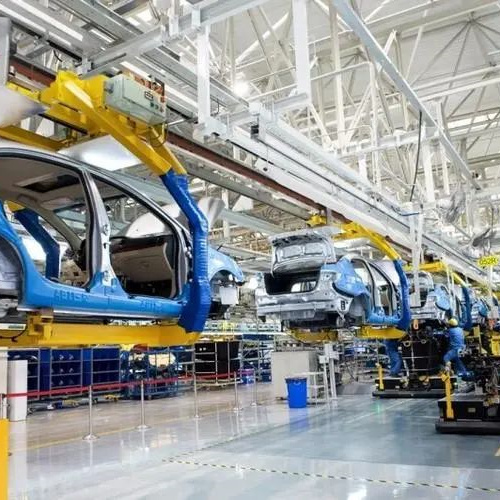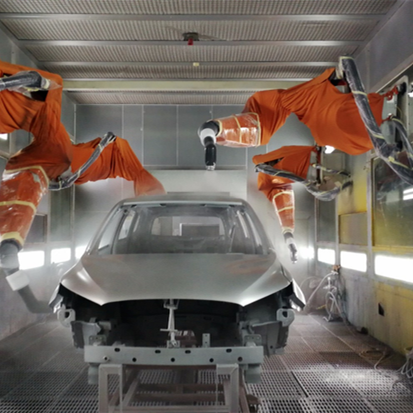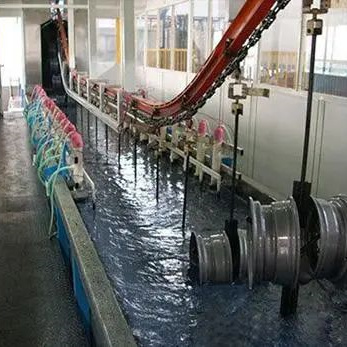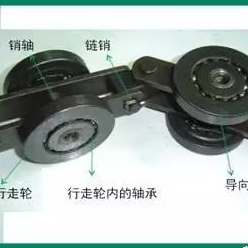What are the different lubrication points and characteristics of the painting line in the automobile factory?
Garage painting
Garage painting is divided into base coating, middle coating and top coating
Pre-treatment (pickling and degreasing/phosphating) is required before coating.
After the bottom coat is dried, then the middle coat is applied, and then the top coat is applied after drying (it can be divided into one coat and two coats).
Spray booth is divided into dry, water spin spray booth, water curtain spray booth, etc
Large drying room various conveying equipment (conveying chain)
Garage painting technology - cathodic electrophoretic painting
Car factory painting process
At present, the more realistic process that meets the requirements of environmental protection is: Electrophoretic paint (primer, drying at 160℃ ~ 180℃) → Water-based coating → Pre-drying (about 80℃ / 10min) → drying (about 150℃ / 30min) → Water-based flash paint → Pre-drying (about 80℃ / 10min) → solvent-based high solid finish varnish → drying (about 130℃ / 30min).
Pre-electrophoresis treatment - degreasing, phosphating
The oil on the surface of the body must be completely removed first, and the degreasing agent is generally water-based alkaline degreasing agent. The degreasing temperature is generally controlled at 50 ~ 60℃.
The degreasing method is best used in combination with spraying, because the impact force during spraying is conducive to oil removal (pressure is 0.06 ~ 0.12MPa, time is 3min), and the impregnation can remove the oil that is not easy to wash inside the workpiece (time is 3min).
The phosphating film suitable for cathodic electrophoresis should be thin (2 ~ 6μm) and the amount of paint absorption is small. The key of phosphating process is to control phosphating temperature, time, content of accelerator, free acid and total acidity of phosphating solution. Generally control the temperature of phosphating solution 38 ~ 45℃, immersion time 3min, total acidity 20 ~ 27 points, free acid 0.7 ~ 1.3 points, zinc content 0.9 ~ 1.2g/L, phosphating out tank spray for 1min, spray pressure 0.04 ~ 0.06MPa.
In addition, the cleaning process after phosphating can not be ignored, and the soluble salt remaining on the phosphating film must be thoroughly washed, because this soluble salt is easy to cause early foaming and falling off of the coating under hot and humid conditions; In addition, this soluble salt into the electrophoresis tank will seriously contaminate the electrophoresis paint. Generally, after phosphating, first clean with tap water spray, and then spray with deionized water.
Oil point for painting line
A large amount of lubrication on the coating line is the lubrication of the transmission chain. The lubrication part of the chain is:
The bearings of the travelling wheel and guide wheel are lubricated with grease;
Between the plate and the plate
Between the plate and the pin
Between the pin and the pin sleeve
The chain link is connected to the pin
Commonly used chain oil injection lubrication
High temperature chain oil requirements
1, good lubrication performance, with excellent anti-wear performance, effectively prevent abnormal wear of the shaft pin, noise and other problems.
2, excellent permeability, can effectively penetrate into the friction parts of the shaft pin to form a stable oil film, lubrication chain, to ensure the normal operation of the equipment.
3, good long-term performance, compatible with paint; Reduce oil consumption under the premise of ensuring lubrication
4, high temperature resistance is not easy to coking carbon, at a high temperature of 250℃ to ensure effective lubrication
5, strong adhesion, especially under high temperature conditions, it is easy to attach to the surface of the chain, which can effectively avoid dripping
6, with anti-rust function, effectively prevent corrosion gas to metal corrosion
7, does not contain silicon components (silicon will have an adverse effect on the powder coating), and does not contain solid lubricants
Coating line high temperature bearing lubrication
Coating line skeleton bearings need to withstand high temperature conditions of nearly 220℃ for a long time; At the same time, it is affected by acid alkali solution and phosphating solution. Need to bear the weight of the workpiece. Improper selection of bearing grease will lead to the increase of bearing sludge, carbon accumulation, coking tendency, bearing wear, cage damage, and even lead to bearing lock failure.
Once the slide bearing is stuck with poor lubrication, it will also have a greater impact on the overall transmission equipment:
(1) The chain traction load increases sharply, resulting in track deformation, collapse and other failures;
(2) Linear drive device overload, jitter, or even stop
(3) Drive chain tooth extraction wear too fast, poor engagement with the rack caused by slippage, or poor separation after the rodent caused by failure.
Lubrication requirements for high temperature bearings in coating lines
For the coating line, the high temperature bearing has high requirements for lubricants, and generally the lubricant needs to meet the following requirements:
(1) High extreme pressure and good wear resistance, able to withstand the weight of the workpiece
(2) High adhesion ability, which can effectively adhere to the friction surface to form an effective oil film
(3) Good high temperature stability, prevent the loss of oil at high temperature, cause the wear of friction pairs, and reduce the waste of oil and the pollution of the workpiece
(4) Excellent antioxidant capacity, good paint compatibility









